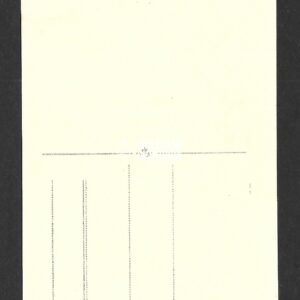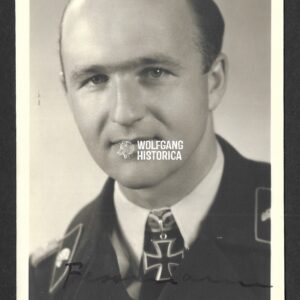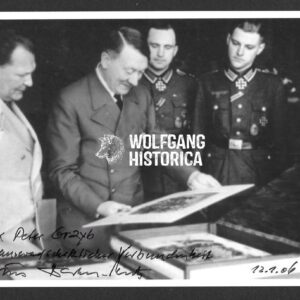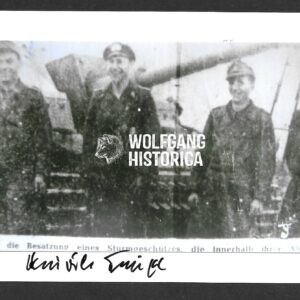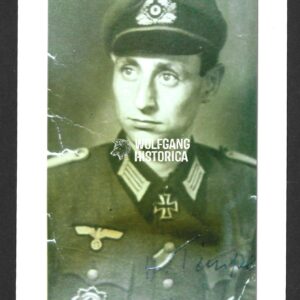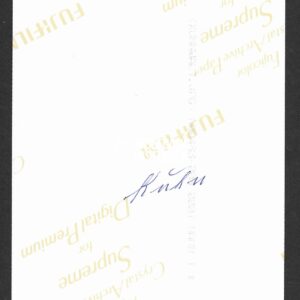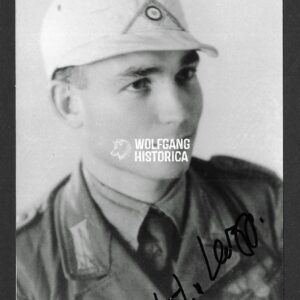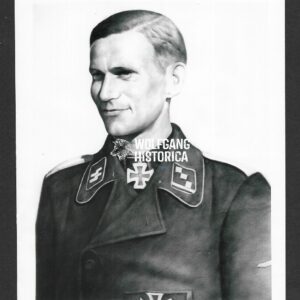Sign in
Login
Register
New Video on YouTube!
Ciney Militaria Show of April 2025
8 May: NEW UNBOXING VIDEO: Check out what’s to come in the next days.
Ernst Barkmann – SS-Panzer-Regiment 2 “Das Reich” (Normandy)
€60,00
Original Postwar Signature on a Postwar Photo of Ernst Barkmann. SS-Oberscharführer Ernst Barkmann (25.08.1919 in Kisdorf † 27.06.2009) earned the Ritterkreuz des Eisernen Kreuzes on August 27, 1944 as SS-Unterscharführer und Panzerkommandant in the 4. Kompanie/ SS-Panzer-Regiment 2 of the 2. SS-Panzer-Division “Das Reich”. Postcardsize. Condition as seen.
Read more
Add to Compare
Kurt Sametreiter – SS-Panzerjäger-Abteilung 1 “LSSAH”
€65,00
Original Postwar Signature on a Postwar Photo of Kurt Sametreiter. SS-Untersturmführer Kurt Sametreiter (09.04.1922 † 28.01.2017) earned the Ritterkreuz on July 31, 1943 as SS-Oberscharführer und Zugführer in the 1. Kompanie/ SS-Panzerjäger-Abteilung 1 “LSSAH” of the 1. SS-Panzer-Division “LSSAH”.
Read more
Add to Compare
Max Wünsche – SS-Panzer-Regiment 1 “LSSAH” & 12 “Hitlerjugend” (Eichenlaub)
€180,00
Original Postwar Signature on a Postwar Photo of Max Wünsche. SS-Standartenführer Max Wünsche (20.04.1914 † 17.04.1995) earned the Ritterkreuz des Eisernen Kreuzes on February 28, 1943 as SS-Obersturmbannführer und Kommandeur of the Stab der I./ SS-Panzer-Regiment 1 of the 1. SS-Panzer-Division “LSSAH” and the Eichenlaub on August 11, 1944 as SS-Obersturmbannführer und Komanndeur of the SS-Panzer-Regiment 12 of the 12. SS-Panzer-Division “Hitlerjugend”. Size: 20x25cm.
Max Wünsche was born on 20 April 1914 in Kittlitz. In July 1933 Wünsche joined the SS. In 1935, he graduated from SS-Junkerschule at Bad Tölz and was promoted to Untersturmführer. Wünsche was then posted to the Leibstandarte SS Adolf Hitler (LSSAH) as a platoon leader. In October 1938, Wünsche was assigned as an orderly officer for Hitler. In that role, Wünsche joined the Führerbegleitkommando (the SS bodyguard unit), which provided personal security for Hitler. In January 1940 he was again posted to the LSSAH, as a platoon commander in a motorcycle company under the command of Kurt Meyer, for the invasion of the Netherlands and the Battle of France. In December 1940 he became an adjutant to Sepp Dietrich during the invasion of the Balkans (Operation Marita) and the invasion of the Soviet Union (Operation Barbarossa). In February 1942 Wünsche was given the command of the LSSAH Sturmgeschütz (assault gun) battalion. In 1942 Wünsche completed the General Staff training course at the Staff College in Germany and was promoted to Sturmbannführer. In September 1942 he was posted to the LSSAH and resumed command of the Sturmgeschütz battalion; in October he assumed command of a battalion in a panzer regiment of LSSAH. His battalion’s first action was at Kharkov in 1943. On 25 February 1943 Wünsche’s battalion went into action against a defensive position manned by the Soviet 350th Rifle Division. Supported by artillery and a company of SS grenadiers, Wünsche’s battalion attacked and overran the Soviet front lines. Wünsche’s assault would lead to the destruction of 47 artillery pieces and anti-tank guns. For his actions during the battles for Kharkov, Wünsche was awarded the German Cross in Gold and later the Knight’s Cross, both in February 1943. In June 1943, Wünsche was transferred to a new division forming in France, 12th SS Panzer Division Hitlerjugend, to take command of the 12th SS Panzer Regiment. On 6 June 1944, the Allies landed in Normandy (Operation Overlord) and the division was committed to action on 7 June. The division was later trapped in the Falaise pocket, where on the night of 20 August, Wünsche escaped on foot. He was wounded and taken prisoner by British soldiers. Wünsche spent the rest of the war as a prisoner of war in camp 165 at Caithness, Scotland, a special camp for high-ranking German officers. In 1948 Wünsche was released and returned to Germany. He died in 1995.
Read more on Max Wünsche (Wikipedia)
Read more
Add to Compare
Paul-Albert Kausch – SS-Panzer-Regiment 11 “Hermann von Salza” (Eichenlaub)
€85,00
Original Postwar Signature on a Postwar Photo of Paul-Albert Kausch. SS-Obersturmbannführer Paul-Albert Kausch (03.03.1911 in Jädersdorf † 27.10.2001 in Ingelheim) earned the Ritterkreuz des Eisernen Kreuzes on August 23, 1944 as SS-Obersturmbannführer und Kommandeur of the SS-Panzer-Abteilung 11 “Hermann von Salza” and the Eichenlaub on April 23, 1945 as SS-Obersturmbannführer und Kommandeur of the SS-Panzer-Regiment 11 “Hermann von Salza” of the 11. SS-Freiwilligen-Panzergrenadier-Division “Nordland“. Condition as seen. Postcardsize.
Oakleaves: Awarded for his leadership of the SS-Panzer-Regiment 11 during the final battles around Berlin. In the fighting east of and inside the city the unit destroyed 487 enemy tanks and was the backbone of many defensive battles, such as that on the 18.04.1945 west of Reichenberg (6 km north of Buckow). Here, out of a force of 70 Soviet tanks attacking from the Ringenwalde area, 50 were destroyed.
Add to Cart
Add to Compare
Paul Senghas – SS-Panzer-Regiment 5 “Wiking”
€55,00
Original Postwar Signature on a Postwar Photo of Paul Senghas. SS-Hauptsturmführer Paul Senghas (31.01.1916 † 06.11.1996) earned the Ritterkreuz des Eisernen Kreuzes on December 11, 1944 as SS-Obersturmführer und Führer of the I. Abteilung/ SS-Panzer-Regiment 5 of the 5. SS-Panzer-Division “Wiking”. Condition as seen. Postcardsize.
“On the 18.08.1944 the enemy advanced towards the Warsaw-Radzymin-Wyszkow road with massive forces and strong air support. At the time the 5. SS-Panzer-Division ‘Wiking’ was located along the general line Roszcep-Trojany-Debynki. At the time SS-Obersturmführer Senghas stood as the leader of the Stabskompanie along with the supply units of the I./SS-Panzer-Regiment 5 in Zazdroso (1.5 km east of Niegow).
At 11:00 he received a message which reported the Russians as having broken through in battalion strength to a point 1 km east of the railway embankment. A wide gap existed towards the left neighbour, and there was the danger that the Russians would block the main road and thrust into the left flank of the Division. Recognizing this danger, Senghas made the decision to engage the enemy with the handful of men in the supply units at hand (despite their lack of heavy infantry weapons) and bring the Russians to a halt.
Going into position at the railway embankment, he let the Russians approach to within very close range and then smashed their attack. Reinforcements could not be brought up, and so Senghas defended with his handful of men for the remainder of that day and also the two following days, fighting off strong enemy attacks with only rifles, sub-machine guns and close combat weapons. During this time 2 Panzer IVs, which had been in the repair shop and were only conditionally operational, were brought into the fight. 2 Sherman tanks and 1 T-34 were destroyed immediately after they appeared. The Russians took heavy losses in men and ceased their attacks.
By his own initiative and personal devotion to duty, Senghas thus brought the 3 days of close combat to a conclusion. An enemy breakthrough was prevented and the danger to the left flank of the Division removed. Senghas is one of the oldest Eastern front combat veterans, who has mastered many critical situations through swift decisiveness and bold action while ruthlessly demanding the utmost of himself.”
Read more
Add to Compare
Wilhelm Keilhaus – SS-Division “LSSAH” & Chef Fernmeldewesen Himmler
€150,00
Original Scarce Postwar Signature on a Postwar Photo of Wilhelm Keilhaus. SS-Brigadeführer und Generalmajor der Waffen-SS Wilhelm Keilhaus (11.12.1898 in Hohenstein-Ersthal † 11.01.1977 in Karlsruhe) earned the Deutsches Kreuz in Gold on April 29, 1942 as SS-Obersturmbannführer und Ia with the Stab/ SS-Division "LSSAH". Postcardsize. Condition as seen.
Read more
Add to Compare
Max Wünsche – SS-Panzer-Regiment 1 “LSSAH” & 12 “Hitlerjugend” (Eichenlaub)
€180,00
Original Postwar Signature on a Postwar Photo of Max Wünsche. SS-Standartenführer Max Wünsche (20.04.1914 † 17.04.1995) earned the Ritterkreuz des Eisernen Kreuzes on February 28, 1943 as SS-Obersturmbannführer und Kommandeur of the Stab der I./ SS-Panzer-Regiment 1 of the 1. SS-Panzer-Division “LSSAH” and the Eichenlaub on August 11, 1944 as SS-Obersturmbannführer und Komanndeur of the SS-Panzer-Regiment 12 of the 12. SS-Panzer-Division “Hitlerjugend”.
Max Wünsche was born on 20 April 1914 in Kittlitz. In July 1933 Wünsche joined the SS. In 1935, he graduated from SS-Junkerschule at Bad Tölz and was promoted to Untersturmführer. Wünsche was then posted to the Leibstandarte SS Adolf Hitler (LSSAH) as a platoon leader. In October 1938, Wünsche was assigned as an orderly officer for Hitler. In that role, Wünsche joined the Führerbegleitkommando (the SS bodyguard unit), which provided personal security for Hitler. In January 1940 he was again posted to the LSSAH, as a platoon commander in a motorcycle company under the command of Kurt Meyer, for the invasion of the Netherlands and the Battle of France. In December 1940 he became an adjutant to Sepp Dietrich during the invasion of the Balkans (Operation Marita) and the invasion of the Soviet Union (Operation Barbarossa). In February 1942 Wünsche was given the command of the LSSAH Sturmgeschütz (assault gun) battalion. In 1942 Wünsche completed the General Staff training course at the Staff College in Germany and was promoted to Sturmbannführer. In September 1942 he was posted to the LSSAH and resumed command of the Sturmgeschütz battalion; in October he assumed command of a battalion in a panzer regiment of LSSAH. His battalion’s first action was at Kharkov in 1943. On 25 February 1943 Wünsche’s battalion went into action against a defensive position manned by the Soviet 350th Rifle Division. Supported by artillery and a company of SS grenadiers, Wünsche’s battalion attacked and overran the Soviet front lines. Wünsche’s assault would lead to the destruction of 47 artillery pieces and anti-tank guns. For his actions during the battles for Kharkov, Wünsche was awarded the German Cross in Gold and later the Knight’s Cross, both in February 1943. In June 1943, Wünsche was transferred to a new division forming in France, 12th SS Panzer Division Hitlerjugend, to take command of the 12th SS Panzer Regiment. On 6 June 1944, the Allies landed in Normandy (Operation Overlord) and the division was committed to action on 7 June. The division was later trapped in the Falaise pocket, where on the night of 20 August, Wünsche escaped on foot. He was wounded and taken prisoner by British soldiers. Wünsche spent the rest of the war as a prisoner of war in camp 165 at Caithness, Scotland, a special camp for high-ranking German officers. In 1948 Wünsche was released and returned to Germany. He died in 1995.
Read more on Max Wünsche (Wikipedia)
Read more
Add to Compare
Rudolf Enseling – SS-Panzer-Regiment 2 “Das Reich” (Normandy)
€150,00
Original Scarce Postwar Signature on a Postwar Photo of Rudolf Enseling. SS-Obersturmbannführer Rudolf Enseling (30.08.1914 † 25.01.1977) earned the Ritterkreuz des Eisernes Kreuzes on August 23, 1944 as SS-Obersturmbannführer und Kommandeur of the I. Bataillon/ SS-Panzer-Regiment 2 of the 2. SS-Panzer-Division “Das Reich”. Postcardsize. Condition as seen.
Read more
Add to Compare
Rudolf von Ribbentrop – SS-Panzer-Regiment 1 “LSSAH” & 12 “Hitlerjugend” (Kharkov, Kursk, Normandy & Ardennes!)
€55,00
Original Postwar Signature on a Postwar Photo of Rudolf von Ribbentrop. SS-Hauptsturmführer Rudolf von Ribbentrop (11.05.1921 in Wiesbaden † 20.05.2019 in Ratingen) earned the Ritterkreuz des Eisernen Kreuzes on July 15, 1943 as SS-Obersturmführer und Führer of the 6. Kompanie/ SS-Panzer-Regiment 1 of the 1. SS-Panzer-Division “LSSAH” and the Deutsches Kreuz in Gold on August 25, 1944 with the 3. Kompanie/ SS-Panzer-Regiment 12 of the 12. SS-Panzer-Division “Hitlerjugend”. Condition as seen. Postcardsize.
He participated in many of the most famous battles of World War II: Kharkov, Kursk, Normandy, Falaise and the Ardennes!
Add to Cart
Add to Compare
Waffen-SS KC Holders book filled with ca. W-SS 140 Signatures!
€1.995,00
Original literature book "Their honour was loyalty : an illustrated and documentary history of the Knight's Cross holders of the Waffen-SS and police 1940-1945" by Jost W. Schneider! Containing circa 140 signatures almost all exclusive Waffen-SS Signatures. Only a few are Wehrmacht ones who were subordinated to Waffen-SS units. Includes rare signatures of Erich Göstl, Josef Diefenthal, Wolfgang Gast, Kurt Wahl and many more...! Incredible time capsule. Book belonged to a former W-SS veteran.
Read more
Add to Compare
Fritz Feßmann – Panzer-Aufkl.-Abt.7 & Kradschützen-Btl. 64 (Schwertern) (Wartime Signed)
€195,00
Original Wartime Studioportrait with Wartime Signature of Fritz Fessmann. Major der Reserve Fritz Feßmann (25.12.1913 † 11.10.1944) earned the Ritterkreuz in June 1940 and the Eichenlaub on October 27, 1941 as Leutnant der Reserve und Zugführer in the 1. Kompanie/ Panzer-Aufklärungs-Abteilung 7 of the 4. Panzer-Division and the Schwertern on January 4, 1943 as Oberleutnant der Reserve und Chef of the 1. Kompanie/ Kradschützen-Bataillon 64 of the 14. Panzer-Division. Measuring: Postcardsize.
Read more
Add to Compare
Gerhard Fischer – Panzer-Regiment 23 (23. Panzer-Division)
€30,00
Original Postwar Signature on a Postwar Photo of Gerhard Fischer. Major Gerhard Fischer (04.12.1915 † 09.08.2014) earned the Ritterkreuz des Eisernen Kreuzes on December 28, 1943 as Oberleutnant und Chef of the 8. Kompanie/ Panzer-Regiment 23 of the 23. Panzer-Division. He also earned the Panzerkampfabzeichen V. Stufe (Einsatzahl “100”). Condition as seen. Postcardsize.
Add to Cart
Add to Compare
Gerhard Fischer – Panzer-Regiment 23 (23. Panzer-Division)
€30,00
Original Postwar Signature on a Postwar Photo of Gerhard Fischer. Major Gerhard Fischer (04.12.1915 † 09.08.2014) earned the Ritterkreuz des Eisernen Kreuzes on December 28, 1943 as Oberleutnant und Chef of the 8. Kompanie/ Panzer-Regiment 23 of the 23. Panzer-Division. He also earned the Panzerkampfabzeichen V. Stufe (Einsatzahl “100”). Condition as seen. Postcardsize.
Add to Cart
Add to Compare
Gerhard Fischer – Panzer-Regiment 23 (23. Panzer-Division) (A5 Size)
€30,00
Original Postwar Signature on a Postwar Photo of Gerhard Fischer. Major Gerhard Fischer (04.12.1915 † 09.08.2014) earned the Ritterkreuz des Eisernen Kreuzes on December 28, 1943 as Oberleutnant und Chef of the 8. Kompanie/ Panzer-Regiment 23 of the 23. Panzer-Division. He also earned the Panzerkampfabzeichen V. Stufe (Einsatzahl “100”). Condition as seen. Large A5 size.
Add to Cart
Add to Compare
Gerhard Fischer – Panzer-Regiment 23 (23. Panzer-Division) (A5 Size)
€30,00
Original Postwar Signature on a Postwar Photo of Gerhard Fischer. Major Gerhard Fischer (04.12.1915 † 09.08.2014) earned the Ritterkreuz des Eisernen Kreuzes on December 28, 1943 as Oberleutnant und Chef of the 8. Kompanie/ Panzer-Regiment 23 of the 23. Panzer-Division. He also earned the Panzerkampfabzeichen V. Stufe (Einsatzahl “100”). Condition as seen. Large A5 size.
Add to Cart
Add to Compare
Arthur Becker-Neetz – Schützen-Regiment 394 (3. Panzer-Division)
€20,00
Original Postwar Signature on a Postwar Photo of Arthur Becker(-Neetz). Arthur Becker (31.12.1920 † 12.10.2016) earned the Ritterkreuz des Eisernen Kreuzes on August 25, 1941 as Unteroffizier und Gruppenführer of the 7. Kompanie/ Schützen-Regiment 394 of the 3. Panzer-Division. Condition as seen. Bit smaller than A5.
Add to Cart
Add to Compare
Heinrich Timpe – Heeres-Sturmgeschütz-Brigade 300
€15,00
Original Postwar Signature on a Postwar Photo of Heinrich Timpe. Leutnant Heinrich Timpe (12.10.1923 in Karnap † 15.05.2015 in Euskirchen) earned the Ritterkreuz des Eisernen Kreuzes on May 7, 1945 as Leutnant und Chef of 1. Kompanie/ Sturmgeschütz-Brigade 300 (Feld). Condition as seen. Postcardsize.
Add to Cart
Add to Compare
Heinrich Timpe – Heeres-Sturmgeschütz-Brigade 300
€15,00
Original Postwar Signature on a Postwar Photo of Heinrich Timpe. Leutnant Heinrich Timpe (12.10.1923 in Karnap † 15.05.2015 in Euskirchen) earned the Ritterkreuz des Eisernen Kreuzes on May 7, 1945 as Leutnant und Chef of 1. Kompanie/ Sturmgeschütz-Brigade 300 (Feld). Condition as seen. Postcardsize.
Read more
Add to Compare
Heinrich Timpe – Heeres-Sturmgeschütz-Brigade 300
€15,00
Original Postwar Signature on a Postwar Photo of Heinrich Timpe. Leutnant Heinrich Timpe (12.10.1923 in Karnap † 15.05.2015 in Euskirchen) earned the Ritterkreuz des Eisernen Kreuzes on May 7, 1945 as Leutnant und Chef of 1. Kompanie/ Sturmgeschütz-Brigade 300 (Feld). Condition as seen. Postcardsize.
Add to Cart
Add to Compare
Heinrich Timpe – Heeres-Sturmgeschütz-Brigade 300
€15,00
Original Postwar Signature on a Postwar Photo of Heinrich Timpe. Leutnant Heinrich Timpe (12.10.1923 in Karnap † 15.05.2015 in Euskirchen) earned the Ritterkreuz des Eisernen Kreuzes on May 7, 1945 as Leutnant und Chef of 1. Kompanie/ Sturmgeschütz-Brigade 300 (Feld). Condition as seen. Postcardsize.
Add to Cart
Add to Compare
Walter Kuhn – Panzerjäger-Abteilung 1 (1. Infanterie-Division, 4x Panzervernichtungsabzeichen!)
€30,00
Original Postwar Signature on a Postwar Photo of Walter Kuhn. Obergefreiter Walter Kuhn (09.01.1920 in Mehlsack-Braunsberg † 01.01.2010 in Gelsenkirchen) earned the Ritterkreuz des Eisernen Kreuzes on August 23, 1943 as Obergefreiter und Richtschütze in the 3. Kompanie/ Panzerjäger-Abteilung 1 of the 1. Infanterie-Division. Condition as seen. Little bit smaller as Postcardsize.
Add to Cart
Add to Compare
Walter Kuhn – Panzerjäger-Abteilung 1 (1. Infanterie-Division, 4x Panzervernichtungsabzeichen!)
€30,00
Original Postwar Signature on a Postwar Photo of Walter Kuhn. Obergefreiter Walter Kuhn (09.01.1920 in Mehlsack-Braunsberg † 01.01.2010 in Gelsenkirchen) earned the Ritterkreuz des Eisernen Kreuzes on August 23, 1943 as Obergefreiter und Richtschütze in the 3. Kompanie/ Panzerjäger-Abteilung 1 of the 1. Infanterie-Division. Condition as seen. Postcardsize.
Add to Cart
Add to Compare
Hellmut von Leipzig – Panzer-Aufklärungs-Abteilung “Brandenburg” & Driver of Erwin Rommel !
€25,00
Original Postwar Signature on a Postwar Photo of Hellmut von Leipzig. Leutnant Hellmut von Leipzig (18.07.1921 in Keetmannshop, Namibia † 24.10.2016 in Windhoek, Namibia) earned the Ritterkreuz des Eisernen Kreuzes on April 28, 1945 as Leutnant und Zugführer in the Panzer-Aufklärungs-Abteilung "Brandenburg" of the Panzergrenadier-Division "Brandenburg". Postcardsize. Condition as seen.
Leipzig was born in South West Africa, son of a naval officer. In 1941, he volunteered for the Afrika Korps. He became driver to Generalfeldmarschall Erwin Rommel, whom Leipzig describes as "the craziest passenger ever", because he always said "Faster!" and when encountering an enemy's minefield, would insist on going and personally guiding Leipzig around the mines. Leipzig fought in the "Battle of Berlin", became a POW in 1945 and spent 10 years in Soviet captivity.
Read more
Add to Compare
Karl-Heinz Boska – SS-Panzer-Regiment 2 “Das Reich” (A5 Size)
€55,00
Original Postwar Signature on a Postwar Photo of Karl-Heinz Boska. Karl-Heinz Boska (18.10.1920 † 22.10.2004) earned the Ritterkreuz on December 16, 1943 as SS-Obersturmführer und Adjutant of the II. Abteilung/ SS-Panzer-Regiment 2 of the 2. SS-Panzer-Division “Das Reich”. Condition as seen. Large A5 soze.
Add to Cart
Add to Compare
Product Status
All Categories
- Campaign Shields
- Combat Awards
- Daggers
- Documents
- Erkennungsmarke
- Finnish Militaria
- Flemish Collaboration
- General Awards
- Iron Cross
- Japanese Militaria
- Medal Bars
- Other Nations
- Photos
- Porcelain & Cutlery
- Portraits
- Stickpins & Tinnies
- Storing & Archiving
- Uniforms
- Wartime Signed
- Wound Badges
- Archive (Sold)
- Awards & Decorations
- Uniforms & Insignia
- Papers & Documents
- Award Documents
- Death Cards
- Military & Civil ID's
- Postcards & Feldpost
- Literatur
- Photos & Postcards
- Signatures
- Kriegsmarine
- Luftwaffe & FJ
- Panzer
- Waffen-SS
- Wehrmacht
Brands
Sorry, we couldn't find what you're looking for












